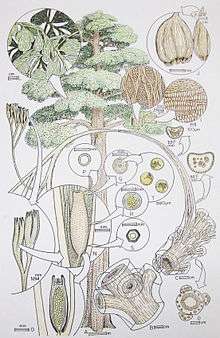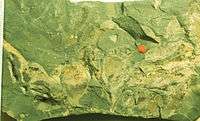Stamnostoma
| Stamnostoma Temporal range: Early Carboniferous | |
|---|---|
 | |
| A reconstruction of Stamnostoma huttonense from the Early Carboniferous Cementstone Group at Foulden Newton, Berwickshire, England[1] | |
| Scientific classification | |
| Kingdom: | Plantae |
| Division: | Pteridospermatophyta |
| Order: | Lyginopteridales |
| Family: | Moresnetiaceae |
| Genus: | Stamnostoma Long 1960 |
| Species | |
|
Stamnostoma huttonense | |
Stamnostoma is an extinct genus of seed ferns based on cupules with seeds. These are among the earliest known seed plants and of earliest Carboniferous (Tournaisian) age.

Cuple of Stamnostoma huttonense from the Early Carboniferous Cementstone Group at Newton Foulden, Berwickshire

Fossil foliage Aneimites acadica from the Early Carboniferous Cementstone Group at Newton Foulden, Berwickshire

The Craiglieth tree, Pitus primaeva outside the Natural History Museum, London
Description
The ovules of Stamnostoma have a complex apex with plug and cone mechanism for creating a chamber for prepollen, as in other Lyginopteridales. Several ovules are borne on an elongate open cupule of bracts.
Whole plant reconstructions
Different organs attributed to the same original plant can be reconstructed from co-occurrence at the same localities in the Scottish Borders county of Berwickshire.
- Stamnostoma huttonense may have been produced by the same plant as Telangium (prepollen organ), Colatisporites decorus (prepollen), Lyginorachis papilio (permineralized petioles), Aneimites acadica (leaves), and Pitus primaeva (permineralized wood).
References
- ↑ Retallack, G.J. & Dilcher, D.L (1988). "Reconstructions of selected seed ferns.". Annals of the Missouri Botanical Garden. 75: 1010–1057. doi:10.2307/2399379.
This article is issued from Wikipedia - version of the 8/6/2016. The text is available under the Creative Commons Attribution/Share Alike but additional terms may apply for the media files.